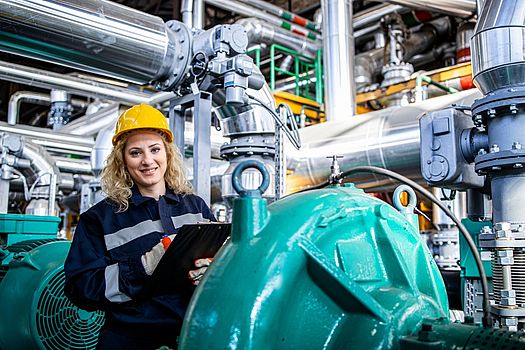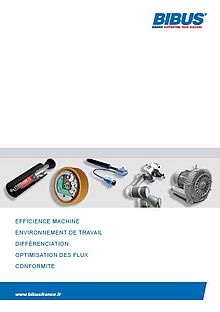The feminization of industry, a performance factor

Industry 4.0 is a high-performance, competitive industry, but it's also an inclusive industry with greater equity and equality.
Changing the way women see industry is just as important as changing the way industry sees women. To meet this major challenge, a number of levers are being put in place: encouraging diversity in technical and engineering fields, offering women training to work with industrial tools, and deploying automated and robotized equipment to reduce the arduousness of tasks.
How does the feminization of production positions contribute to the performance and competitiveness of the industrial sector?
I / Few women in industry: a question of mentality?
According to INSEE, since 1990, only 30% of employees in industry have been women, with just over 15% holding management positions and 10% to 15% working in core businesses such as production. Women are least represented in the metal, automotive and aerospace industries.
Today, women in industry are still perceived as heroines who have defied prejudice and the established order.
The feminization of companies consists in hiring a trained and competent woman for a position that has previously been occupied only by men, considered, by habit or necessity, as the only ones capable of carrying out the inherent tasks.
The arduous nature of tasks and the need for considerable physical effort are perceived as structural elements of certain industries, such as logistics or automotive. Women are not attracted to these industrial jobs, because they are not attractive. There are several reasons why they don't fit in: the requirement for a certain physiognomy to move heavy loads, leading to musculoskeletal disorders (MSDs); the fear of performing monotonous, repetitive tasks in a dangerous, all-male environment; and a lack of flexibility (in terms of task organization and working hours).
With more men having studied technical and digital engineering, they are currently the best placed to fill positions in Industry 4.0. As a result, we are currently experiencing a certain slowness in the concrete and significant implementation of women's employment in this sector. However, we hope that the communication efforts of manufacturers and the deployment of high-tech solutions such as robotics will drive forward gender diversity within companies in all industrial sectors, because there is so much to gain for everyone.
II / The benefits of feminizing industrial production positions
An inclusive corporate culture helps to change mentalities and represents a societal challenge. In addition to the skills of its operators, a company's performance is measured by its efficiency, attractiveness and resilience. Within production lines, inclusivity is thus part of a performance strategy that offers many advantages to the company.
A complementary approach
At the heart of warehouses, factories, workshops, production line teams, gender diversity brings a new outlook, a different experience, a new balance.
A mixed workforce is a new way of thinking. Flaws in production processes are identified and tackled from different perspectives, postures and strategies, and new work logics emerge, particularly in terms of ergonomics and organization.
Responding to labor shortages
The training and recruitment of women is becoming a crucial factor in coping with shortages. Passionate, qualified women can broaden and diversify a pool of expertise and skills.
What's more, vacancies caused by a lack of specialized operators can be filled by trained women, thanks to intuitive automatic and robotic solutions. The feminization of the workforce helps to maintain skills and know-how in the workshops, thus contributing to the long-term viability of the company.
That's why employing women is becoming a sine qua non for reindustrialization.
Positive corporate image and attractiveness
A company that values diversity is perceived positively by its customers. It can also be an asset when it comes to standing out from the competition.
The company is also more attractive to candidates, who will be even more keen to invest in a company that does not discriminate against them on the basis of gender, but hires them for their skills and experience.
An inclusive company improves the quality of life at work, which in turn makes operators more committed and more attached to their company.
Men and women stand to gain from working together. According to the principle of equality, what's good for women is also good for men, so gender diversity in the industrial sector can help improve conditions for all employees in terms of career development and reconciling work and family life.
III / Industrial equipment, a lever for increasing the number of women in jobs and boosting competitiveness
Automation and robotization are eliminating the need for physical strength, enabling the development of higher value-added tasks. Production lines are becoming more attractive, encouraging women to apply for jobs where the nature of the work has changed. Tasks have evolved to call for skills linked to technical mastery, know-how, organization and flexibility.
Robotic and electrical solutions for moving loads
Collaborative robots perform a multitude of tasks and can therefore be deployed in virtually all industrial fields.
● Grippers enable a wide range of applications in collaborative robotics.
They can easily be fitted to robotic arms. A wide variety of gripping and detection systems can automate high-precision handling of delicate parts, particularly in machine shops, or the carrying of heavy loads, thus reducing the risk of RSI.
In logistics, robotic arms equipped with specific grippers can handle, transfer and move open or closed boxes, and load or unload pallets, adapting to the pace of production. They facilitate automated pick & place by detecting objects, their shape, number and color. They also help to facilitate and standardize the integration of women and seniors into more flexible logistics centers.
To replace manual forklifts:
● ez-Wheel's SWD® safe, autonomous and programmable drive wheels customize and motorize industrial forklifts and rolling equipment to move heavy loads of up to 1,500 kg, reducing pushing and pulling effort.
● HD and LD mobile robots. Different models enable loads of up to 1500 kg to be moved autonomously through a warehouse, and the environment to be made safe.
Mechatronic solutions for effortless lifting and lowering
Easy-E-Line electric cylinders and gas cylinders from Bansbach, electric cylinders and lifting columns from Jiecang, are solutions that help technicians in their day-to-day work of pushing and pulling moving parts, whatever the industrial sector.
The cylinders can be deployed for a wide range of applications, since they can customize a wide range of equipment and make tools ergonomic by adjusting the height of worktops and increasing the effort required to raise and lower platforms.
The slow increase in the number of women in production positions in France reflects changing attitudes and the uneven deployment of automation solutions in industry, making it difficult to systematically recruit women.
Yet by offering these solutions, players like BIBUS France are making this inclusivity possible, a strategic issue in the performance and innovation of Industry 4.0.
Contact our experts to help you transform your processes, which will have an impact on your performance and your corporate vision.























